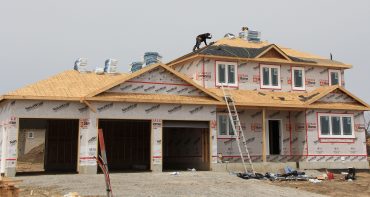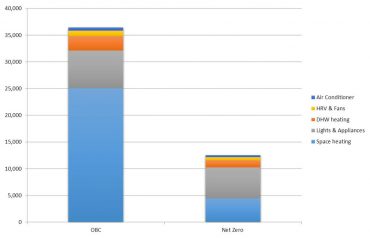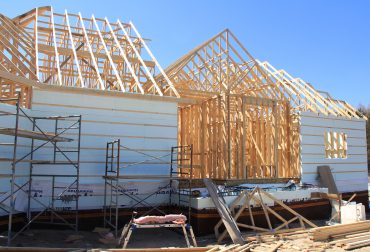
John Bleasby
Sealing the envelope — Meeting the Net Zero Energy challenge (Part One)
Canadian ContractorCan our industry balance home affordability with energy-efficiency requirements?
With Net Zero Energy-ready the ultimate goal for new Canadian housing by 2030, one might consider energy-efficiency, internal air quality and energy generation the three critical columns of support.
In the meantime however, building codes are in a state of flux from province to province, leaving the industry adapting to evolving regulations on-the-fly. Canadian Contractor examines how the industry is positioned today, starting with the building envelopes themselves, and how the increased awareness of energy-efficiency meshes with the challenge of keeping homes affordable.
Residential construction could be divided into two solitudes. Custom homes, typically built to higher budgets and overall standards of comfort, tend to be leaders in the use of advanced building envelope materials like Insulated Concrete Forms (ICF’s), spray foam, advanced thermal breaks and triple pane windows. However, development homes need to reach the same NZE-ready outcomes. Can they do so without making radical changes to building construction techniques and materials?

With NZE-ready only a few years away, many volume builders remain reluctant to make changes in their construction processes
Energy-efficiency is not at the top of consumers’ wish lists
Most homes in Canada are built in volume in a standardized frame construction manner. Because of their unit numbers , they must therefore dominant any NZE-ready discussion. Similarly, charting their progress down the path to NZE-readiness is critical if the federal government is to achieve the goal of new homes ‘ready’ to balance energy consumption with energy generation by 2030.
Builders must build and sell. So what do consumers really want?
What is sometimes forgotten in the zeal to achieve lofty NZE-ready objectives is the fact that home developers not only build house but sell houses. Affordability will always be a key part of their marketing plan. It’s a matter of balancing what theorists want with what consumers want and can afford.
The Canadian Home Builder’s’ Association (CHBA) regularly surveys home purchasers to learn what features top their wish lists. It is interesting to note that in their recent survey of nearly 22,000 new home buyers from six provinces, high overall energy efficiency was only number five, behind walk-in closets, energy efficient appliances and windows, and linen closets.
In other words, just bragging about energy efficiency on its own will not make a new home a seller. At a presentation during the Buildings Show in Toronto last November, representatives from Minto Development and Reid’s Heritage Homes, two leading Ontario home developers who built NZE-ready pilot projects recently, made this point clear —it’s the sizzle not the steak that sells. More than just marketing an energy-efficient home, Minto and Reid’s sales teams have learned to emphasize quietness, draft-free comfort, and the quality of construction detailing associated with an improved building envelope.
What’s the feedback from consumers? “I can’t believe how much better I breathe— my allergies are so much better,” “The home is incredibly quiet — I actually thought my fridge was broken, as I hear it run now,” “It is so comfortable throughout the home. I do not have any cold areas.”
Volume builders must remain efficient builders
It comes down to this question; “What is the average consumer prepared to pay for improvements in energy-efficiency?” At the end of the day, the sticker price must be within reach of the builder’s target market. To stay profitable, volume construction methods must also remain as efficient as possible. As a result, we’re only seeing minor variances in how development homes are constructed, not major overhauls of techniques and materials.
For example, the CHBA suggest that a 50 per cent improvement in heating and cooling efficiencies is possible simply by adding triple pane windows, basement insulation and exterior rigid foam under the siding. These three items require only tweaks in the way volume homes are currently built. Minto and Reid spokespeople agreed — doing a better job with the little things can make a huge difference. Spray foaming and taping around window and door installations, for example, have proven effective means to the desired end.

Incremental changes in building construction detailing resulted in huge energy benefits in Minto’s NZE-ready pilot project, when compared to a standard code-built home, notably in heating. (graph: The Minto Group)
Focus on improved envelopes simplifies the NZE-ready equation
This incremental improvement, however slight, confirms an industry shift towards a more passive energy-efficiency approach to home construction, coinciding with whole-home R-values taking precedent over individual building components ratings.
Yet, key elements of a true passive home are still missing: building orientation and design, and roof line modifications for future solar installations, for example. “Seal the envelope and energy needs will be reduced” —it’s a straight-forward approach from an industry reluctant to make radical changes to building processes. The NZE-ready homes built as part of pilot projects across Canada by developers like Minto and Reid’s Heritage Homes in fact look like any other home on the street. Perhaps that is a required part of the marketing strategy.
Major changes in construction processes? Not so fast!
Are volume home builders likely to move towards proven, higher quality envelope construction materials like ICF’s for example? Probably not, and they admit it. Aside from the question of perceived cost premiums, the re-training of crews is the main reason. It’s one thing to train a team to make time for small improvements in their current techniques, but quite another to re-train them for ICF or even ICF panel construction. While those advanced materials may influence the industry over the longer term, they will likely remain a niche market in terms of overall unit volume production.

Builders with a tradition of frame construction can now consider insulated panels with embedded strapping that work within current practices.
Even the ICF industry itself appears resigned to this, with one executive admitting to Canadian Contractor that he sees the day when volume builders move towards SIP’s, not his company’s ICF’s. Structural Insulated Panels, it was explained, can be manufactured with precision and in high volume in an economical factory setting, and then sent out for quick assembly by small crews using a crane.
There are many routes to achieving the high levels of energy-efficiency that will be required over the next dozen years. Both the custom home and production volume segments of the industry will find their own path.
Keep up with this new series:
Part 2: ‘Change is in the Air’: Interior Air Quality (IAQ) and today’s tight houses
Part 3: Questions & Answers On IAQ and negative air pressure
Got feedback? Make your opinion count by using the comment section below,
or by sending an email to:
JBleasby@canadiancontractor.ca
Follow John on Instagram and on Twitter for notifications about his latest posts

![]()

Leave a Reply